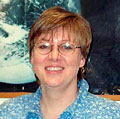 |
|
|
| Author |
Message |
Patty_Cie

Joined: 23 Mar 2004
Posts: 87

|
 Posted:
Wed Jun 02, 2004 6:20 pm Posted:
Wed Jun 02, 2004 6:20 pm |
  |
May 26, 2004 Wednesday
10:30 PM Alaska time
We are still in heavy ice. The ice coverage is called 10/10, which means the water is about 100% ice covered. Unrelenting, the ship continues making progress toward East Hanna Shoal 1 (EHS 1). Meanwhile, I have enjoyed another fascinating day on the Healy. At a new station named EHS 0.5 (located about half way between EHS 0 and EHS 1) I followed scientists, Bob Campbell, from University of Rhode Island, Carin Ashjian, from the Woods Hole Oceanographic Institution in Massachusetts, and Stephane Plourde, from the Department of Fisheries and Oceans, Canada. Bob, Carin and Stephane are working together on the mesozooplankton component of the Arctic Ocean food web. Mesozooplankton are microscopic animals that measure between 200 microns and 2 millimeters. Mesozooplankton prey on phytoplankton (algae and diatoms) and smaller zooplankton (microzooplankton). The scientists are conducting grazing experiments to determine what fraction of available food is eaten and assimilated (not passed through the body as waste material) by mesozooplankton. They are also looking at mesozooplankton reproduction.
It would be near impossible to do a study involving every species of mesozooplankton. Instead, Bob, Carin and Stephane are concentrating on the dominant mesozooplankton species that have the most impact on grazing. In the arctic the dominant mesozooplankton are copepods. Copepods look like tiny shrimp. On the arctic shelves, Bob, Carin and Stephane use a small-sized copepod genus, Pseudocalanus, and a large-sized copepod species, Calanus glacialis. In the basins, they use the large-sized copepods, Calanus glacialis and Calanus hyperboreas.
To collect live copepod specimens, Bob, Carin and Stephane use a vertically towed ring net. The one-meter diameter net is attached to a winch wire and lifted into the air. It is gently placed into the water column and lowered with lead weight to a predetermined depth. There is a flow meter mounted inside the net to measure the exact amount of water flowing through the net as it is lifted to the surface. When the net reaches the surface, a small amount of water is used to move any organisms clinging to the sides into the collection tube at the tail of the net. The collection tube is then emptied into waiting containers on the back deck.

The plankton nets are washed from the outside to gently move organisms to the collection tube.

A plankton sample.
Grazing experiments are conducted on live copepods to describe feeding rates and food choices. A precise number of copepods are introduced into a bottle of whole seawater. The bottles are screen-wrapped and placed in an incubator for 24 hours. Additionally, control bottles (same water but no added animals) are also screen wrapped and placed in the incubator for the identical 24-hour period. When the incubation is complete, the chlorophyll concentration and numbers of phytoplankton and microzooplankton are sampled from both control and experiment bottles. The difference between the two bottles is the amount of food consumed by the introduced copepods.
To gain further understanding of the mesozooplankton grazing impact, it is important to know the number of copepods present. To estimate the copepod numbers, some samples are preserved onboard the Healy and taken back to the scientistsí home laboratories. The mesozooplankton samples are counted and the number of copepods present in the Artic Ocean shelves and basins is extrapolated from the sample counts. By combining the feeding rates with the number of copepods present, scientists can estimate the grazing impacts of the mesozooplankton on phytoplankton and the microzooplankton.

Bob Campbell is capturing copepods that will be placed in the bottles. A dissecting microscope can be seen in the background.

Carin Ashjian is carefully making a record of each bottle. Documentation is vital to the scientists. Notice the blue screen-wrapped bottle on the counter.
To study copepod reproduction, Bob, Carin and Stephane first isolate female copepods in Petri dishes for 24 hours. After 24 hours they see how many copepods lay eggs and how many eggs are in each clutch (batch). They are also investigating copepod egg viability. They collect copepod eggs and incubate the eggs for six days. At the end of six days, they count how many larval copepods are present (i.e. how many eggs hatched). By comparing the number of eggs hatched egg to the beginning egg count, the group calculates the viable egg production of the dominant mesozooplankton species.

Stephane Plourde pulls out a rack of female copepods kept in Petri dishes.
To see photographs taken by Steve Roberts of UCAR/JOSS, click here. |
|
|
    |
 |
|
|
|
View next topic
View previous topic
You cannot post new topics in this forum
You cannot reply to topics in this forum
You cannot edit your posts in this forum
You cannot delete your posts in this forum
You cannot vote in polls in this forum
You cannot attach files in this forum
You can download files in this forum
|
Powered by phpBB 2.0.11
© 2001, 2002 phpBB Group :: FI Theme ::
All times are GMT
| |
